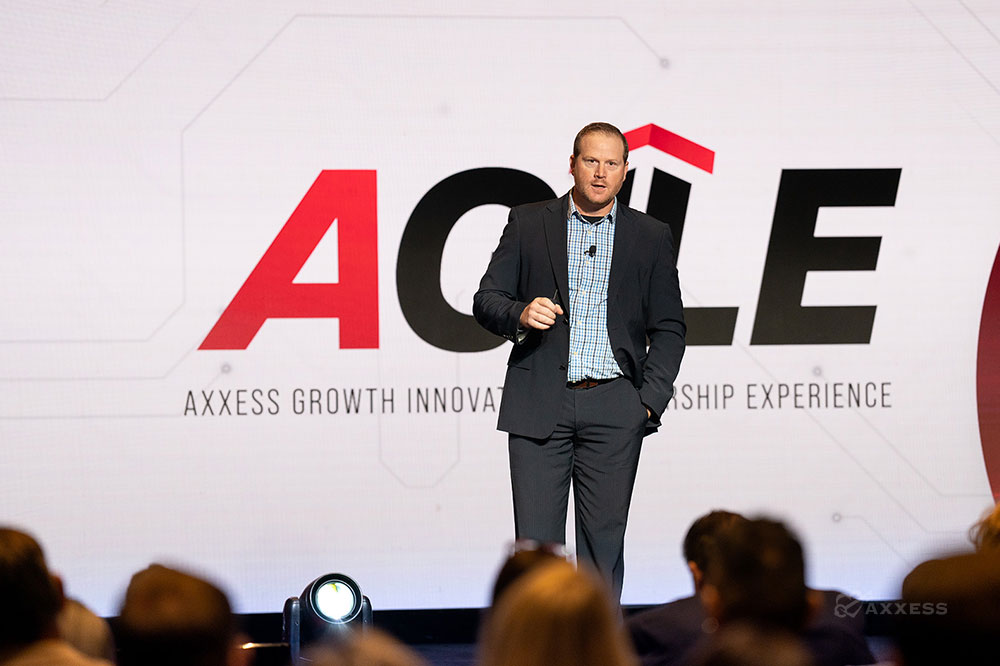
“We’re at a paradigm-shifting moment,” Dan Weberg, Ph.D., MHI, RN, said in his session at the 2023 Axxess Growth, Innovation and Leadership Experience (AGILE). “That means the old way of doing things is no longer relevant to the path we need to move forward.”
He channeled his experience in nursing, healthcare innovation and human-centered patient design to lead a discussion on navigating healthcare’s paradigm shift.
The State of Healthcare
Weberg broke down the following principles to show where he thinks healthcare is headed:
- Everyday life is the new context of care.
- Integrated care teams are linked to people, not places.
- Personalized health experiences are enabled with technology.
“All of these things are driving our health systems forward,” Weberg said. “But then you look at how organizations – some of the big organizations – are reacting to the future of healthcare. They’re building new towers. They’re adding inpatient beds. They’re building new service lines that may not be relevant to where healthcare needs to be delivered, which is out in the community beyond four walls.”
The Science of Innovation
“In every other aspect of your life, you can order something and get it in two hours,” Weberg said. “So, consumers are demanding a different way and it’s causing a case for us to be innovative.”
Weberg referenced the book Managing Innovation by Joe Tidd and John Bessant to illustrate the reasons an industry is forced to change:
- Fractures on the fault lines – cracks in the system get wider over time to where the product no longer meets the needs of the consumer
- Unthinkable events – wars, pandemics, disruptions to the economy
- Running out of road – the product you’re providing is no longer relevant to the people purchasing that product
“If you take all those three things, and you think about healthcare, we are at the perfect moment where all three of those bubbles come together, and it is time for disruptive innovation,” Weberg said.
Innovation was a key pillar of AGILE, yet Weberg asserted you don’t need to be an innovator to lead innovation. Leading innovation involves creating the safe space and resources for people to make changes.
“As leaders of change and disruptors in an industry that has a very long legacy of not being change-ready, we have to use the science of change to be effective,” Weberg said. “The science tells us that high-performing organizations have two very interwoven competencies. The first one is they’re really good at performance improvement. They can optimize what they do and make it super efficient. They can also be innovative, which means bring in new ideas, new ways of work, and test them out.”
Building an Innovation Team
Weberg noted six things that organizations need to have embedded in their culture and operations to thrive in chaotic environments:
- Autonomy – people who are closest to the problem solving that problem
- Reproduction – succession plans, backup systems, redundant systems
- Repair – the ability to recover from stress and conflict
- Survival instinct – focus on team survival, not individual survival
- Adaptation – encouraging change behaviors and new ideas
- Evolution – the ability to shift, reorganize and restructure teams to evolve the practice over time
Weberg laid out the following personas for organizations to adopt on their innovation teams:
- Positive deviants – people who thrive in systems that are failing
- Systems thinkers – people who can see the ripple effects throughout the system
- Network engineers – people who make friends across the board
- Operations mindsets – people who provide a box to focus innovation and implement it more quickly
Top Causes for Innovation Uncertainty
“Middle management is usually the biggest barrier to change, so if we’re trying to implement something big – a reorganization, a new technology, a new workflow – we need to work with them first,” Weberg said. Top causes for innovation uncertainty and failure to innovate include:
- Celebrating unimportant projects
- No limits on the number of projects
- Reluctance to kill an idea
- Weak selection criteria
- Weak decision criteria
- Treating innovation as a “side gig”
Starting With One
Weberg concluded the session by encouraging organizations to start with one thing.
“Start with one,” Weberg said. “Learn one new technology. Modify one team tomorrow that’s just not working well, a service that’s not helpful. Create one new partnership. Have that conversation with that person that you’ve always wanted to and haven’t…and worry about one less laggard.
“If you do that, then you’ll have the power to shift the industry toward what John [Olajide] said this morning: ‘The future of healthcare is in the home,’” Weberg continued. “It’s not in a tower in an ICU somewhere in a hospital. People don’t want to be there. That’s an industrial revolution model of healthcare. We need to move into the network complex model, and that’s home care.”
With more than 250 attendees, more than 40 sponsors and countless connections made, AGILE 2023 was a massive success for everyone. Check out the recap video and mark your calendar for AGILE 2024, April 21-24 in Dallas.
